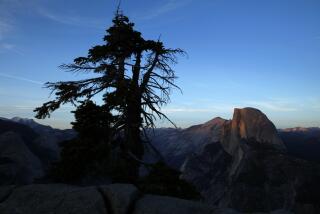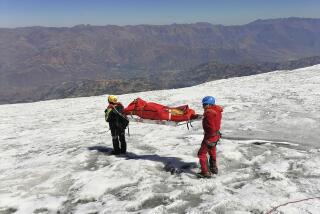She Knows the Nose : The Goal Was to Climb Along the Prow of El Capitan in Yosemite Without Ropes, and Hill Was the First
To non-climbers, the phrase “Free the Nose” might sound like a bit of nonsense--or perhaps the demands of a peculiar protest group--but to climbing aficionados it represents one of the sport’s long-sought goals.
The Nose is one of Yosemite’s classic big-wall climbing routes, one that ascends straight along the prow of El Capitan, the 3,000-foot granite monolith that is one of the national park’s landmarks. Free is short for free-climb: To climb each pitch without the help of a rope--except for protection against a fall--or other climbing aid.
First up the nose, in 1958, was Warren Harding. With bolts and pitons (some fashioned from stove legs), Harding and a series of partners pioneered the route in 45 days of climbing, spread over 18 months. Other firsts followed: the initial solo ascent, the first ascent in a single day.
Eventually, many of the big-wall climbs in Yosemite were achieved by those who inched their way up without the use of climbing aids, but the Nose was slow to go. The 34 sections--or “pitches”--on the route fell one at a time to free-climbers, but by last summer no one had free-climbed the entire route, and two of the pitches had never been climbed without aid.
John Bachar, one of the sport’s best and a veteran of 20 years of climbing in Yosemite, had heard speculation on when the route would go free for as long as he could remember. Several tried, only to be stopped by the most storied pitch on the route, the Great Roof, a dramatic overhang that requires some difficult crack climbing.
Then, last August, climber Lynn Hill solved the Great Roof on a free-climbing attempt on the Nose, only to be stymied by another difficult pitch higher up. She was back the following month and this time free-climbed the entire route, reaching the top on Sept. 16. In an endeavor still largely dominated by men, Hill had scored one of climbing’s biggest coups.
“While everybody’s sleeping, she grabs the prize free-climbing route in the country, maybe on the planet,” Bachar said. “It’s one of the premier bags of all time.”
*
Hill is hardly unknown. Climbing’s first female star, she dominated competitive sport climbing for its first several years and has more than 20 World Cup titles to her credit.
On a promotional tour, Hill made a recent stop at an indoor climbing gym in Costa Mesa, drawing an admiring crowd for an afternoon climbing demonstration, then selling out two evening slide shows to their 300-seat capacity.
Hill, 33, got her first glimpse of El Capitan on a camping trip with her family when she was 13 and lived in Fullerton. The next year, she got her first taste of climbing when an older brother and sister introduced her to it at Lake Perris. On subsequent trips to Joshua Tree, a climbing mecca in the high desert, she became hooked.
Hill graduated to tougher and tougher climbs, eventually returning to El Capitan for a classic-style three-day ascent in 1979. In the ‘70s, climbing was still largely an esoteric endeavor. “When I started climbing, (it) was not a cool sport--people didn’t think of it as a sport at all,” Hill said. “I liked the spontaneity of climbing and the natural environment and the freedom.”
Hill’s reputation continued to grow, and in 1986 she was invited to climb in one of the first international competitions, in Arcos, Italy. She won and went on to dominate the sport in its early years. In sport climbing, pursued primarily on artificial walls, climbers compete against each other on increasingly difficult routes.
In 1992, Hill was still one of the top women in climbing, winning several major competitions and finishing third overall in the year-end World Cup standings. Still, she decided to cut back on competitive climbing to concentrate on other projects, including a book, business interests and a renewed emphasis on climbing natural rock.
El Capitan continued to interest her. About six years ago, climber and close friend John Long had suggested a free-climbing assault on the Nose. “It wasn’t a new idea, but it stuck in my mind,” she recalled. In the summer of ‘92, she returned to the Nose for a one-day ascent with a partner.
Although she wasn’t able to study closely the logistics of a free-climbing ascent then, Hill said: “Ever since then, I thought I really want to come back and try this free. The seed was planted in my brain.”
She came back last summer, looking for a partner, and finally hooked up with British climber Simon Nadin for an August attempt. The two were pressed for time, and their ascent was slowed when they continually crossed paths with a team of Croatian climbers. Although she was tired, Hill managed to solve the Great Roof on her final try. The next day, however, the pitch above Camp 6 proved too much, and the pair climbed past it to the top with help of ropes.
Hill called Steve West, a representative of her climbing shoe sponsor, with news of her climb, and he persuaded her to go back to get some photographs on the Great Roof. She agreed, with thoughts of trying the full climb again, and upon her return to the valley was joined by climber Brooke Sandahl.
During the photo session, Hill was able to refine her technique on the Great Roof pitch; also, she worked out the moves at Camp 6, which had defeated her on the previous attempt, and knocked out a broken piton from a tiny crack that might come in handy. She said that after three days of practicing on the pitch, “I was pretty sure it would go. I had not linked it yet, though--I had done it in sections.”
The pair started the climb, and this time everything came together--the weather held clear until the end of the climb; the traffic on the popular route wasn’t a hindrance and Hill was climbing well. She again handled the Great Roof--although Sandahl had to climb with aid--and this time was able to free-climb the Camp 6 pitch with the help of the tiny crack she had cleared and some unconventional moves.
On Sept. 16, after 3 1/2 days on the rock, Hill and Sandahl made it to the summit. “I was just really happy,” Hill said. “It was still light out, and we had time to relax and make a fire.”
Other climbers joined them and, she added: “We had a really nice time, sitting around the campfire like the good old days.”
The climb left her exhilarated, not tired. “I definitely felt like I had put in my three days of hard effort, but I didn’t feel exhausted,” she said. “You don’t feel exhausted after you’ve done something significant like that. You feel good.”
*
That a woman was the first to climb the route surprised some, but Hill has long maintained that climbing is ideally suited to females. It is less dependent on brute strength than on the strength-to-weight ratio, and at less than 110 pounds Hill is lean--and strong.
Only 5 feet 2, she is sometimes at a disadvantage because of her reach, but on this climb her small hands and fingers were actually a boon during some of the more difficult crack climbing.
“She’s a phenomenal climber anyway, but in this case, it’s ironic that she had an advantage,” Bachar said. “The reality of crack climbing is, if you can’t get your fingers in the crack, you can’t climb it.”
Hill feels pride in her accomplishment, but knows that other previously “unclimbable” routes will fall. “I’ll never say that the challenges are drying up, because there’s always vision. There’s always the potential for someone to have the idea for something grand,” Hill said.
“(But) a challenge like that, that was kind of like plucking the classic, I think.”
After her current tour, Hill will head home, to the Provence region of France. As for her next big challenge, she’s not sure yet, but she may not be done with El Capitan.
“I’m thinking of doing it all free in a day. I would like to do that, but I almost feel like I don’t want to dwell too much on one route,” she said. “I like the effort of a long climb . . . sort of a balance between technical challenge, length, aesthetic beauty--all those elements are really important to me.”
More to Read
Sign up for The Wild
We’ll help you find the best places to hike, bike and run, as well as the perfect silent spots for meditation and yoga.
You may occasionally receive promotional content from the Los Angeles Times.






